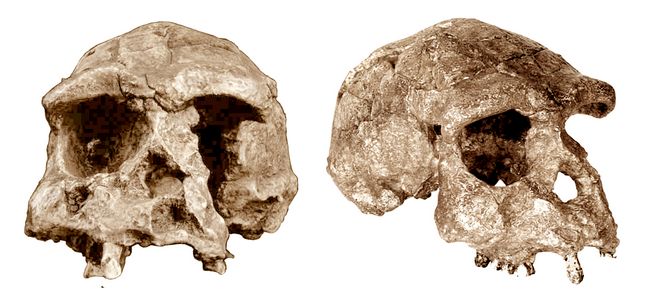Athena Review Image Archive ™
Homo erectus Sangiran 17 skull

Front and side views of skull of Sangiran 17 from Java (afte)
The fossil cranium known as Sangiran 17 was discovered at Sangiran in the Solo River valley of central Java in 1969 by Towikromo. The most complete Homo erectus skull found in East Asia, it dates from 700,000 years ago. It has the prominent brow ridges and thick skull bones typical of Homo erectus, and a relatively large brain size. The cranial capacity is estimated at 1004 cc, equivalent to those of some Homo erectus crania found in China, and slightly larger than that found at Trinil in east Java (Wu et al 2010).
The
site of Sangiran was first briefly explored for fossils in 1883 by
Dutch paleoanthropologist Eugène Dubois, who then worked at Trinil, where he found the first skull and legbone of Pithecanthropus erectus (now Homo erectus). Beginning in 1934 Ralph
von Koenigswald conducted excavations at Sangiran, finding various H.erectus
fossils including Sangiran 2, an upper skull fragment with an estimated
cranial capacity of 813 cc (Holloway 1982). The site also has many
fossils of animals contemporary with Homo erectus.
Reference:
Holloway, Ralph 1982
von Koenigswald
Wu et al. 2010
Copyright © 1996-2020 Rust Family Foundation (All Rights Reserved).